Wednesday afternoon saw a packed house at Delphy in Bleiswijk. With more than 220 registrations, the LightEvent was filled to capacity. There was plenty to discuss, as evidenced by the decibel levels during the coffee breaks.
During the plenary opening, the crowd watched the figures that Corné van Steekelenburg of Samax conjured up on the screen. A series of workshops then covered (positive) practical experiences with LED lighting, new research results, and technical progress.
Hard figures
"Take action," Corné urged the audience during his presentation. The crux of his talk on the 'economics of lighting' was: ensure flexibility and a more diverse package of heat sources. Relying solely on CHP (Combined Heat and Power) is no longer (economically) viable.
The CEO of the company, which assists around forty businesses with their energy management, recalculated the consequences of the new legislation for the audience. For example, for lit vegetable cultivation, the energy costs per square meter are expected to increase by 9.12 euros per square meter between 2024 and 2030.
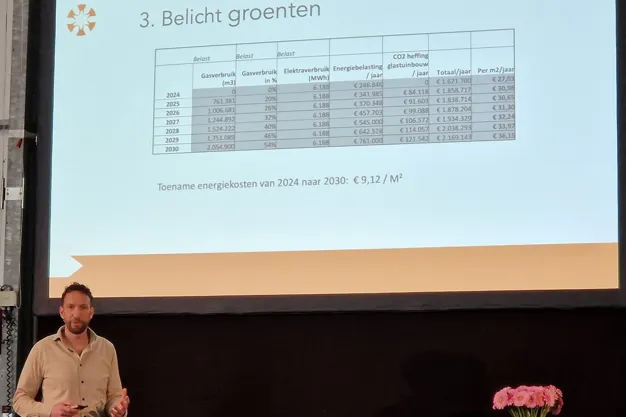
Corné van Steekelenburg, from Samax.
Originally, the organization planned to start the afternoon with a presentation on how retail, the sector, and consumers view lighting in the near future with current sustainability issues. However, this did not materialize, as Dennis Medema of Dutch Greenhouse Horticulture explained. They organized the afternoon together with Wageningen University & Research Business Unit Greenhouse Horticulture, Delphy Improvement Centre, and Plant Lighting as part of the Greenhouse as Energy Source program.
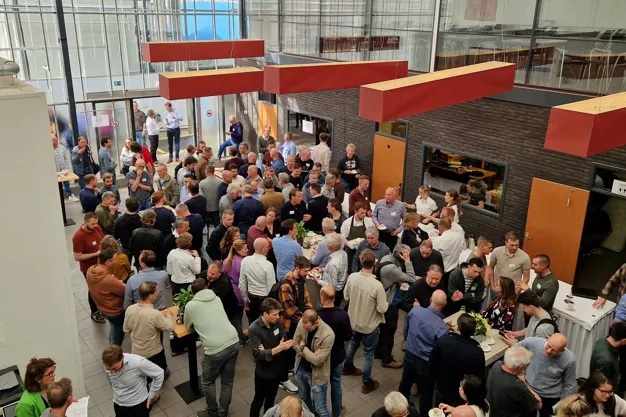
A full house at the Delphy Improvement Centre.
Practical experience: evaporation 'at an acceptable level'
After the limited plenary session, it was time for thirteen workshops and three tours. From this extensive program, participants could choose three parts. Those who opted for practical cultivation experiences heard from cultivation manager Cees Maan from Lans. The large tomato grower uses special LED fixtures, with an integrated fan. In the future, Lans would like to be able to control the fans separately from the fixtures, as well as the colors in the LED lamp. The LED lamps are dimmable already.
Last winter, Lans used a few greenhouses with hybrid lighting and a few with full-LED. In the full-LED cultivation, the intensity was increased from 200 to 300 micromoles. This enabled the growers to get evaporation, a challenge in LED cultivation, 'to an acceptable level'.
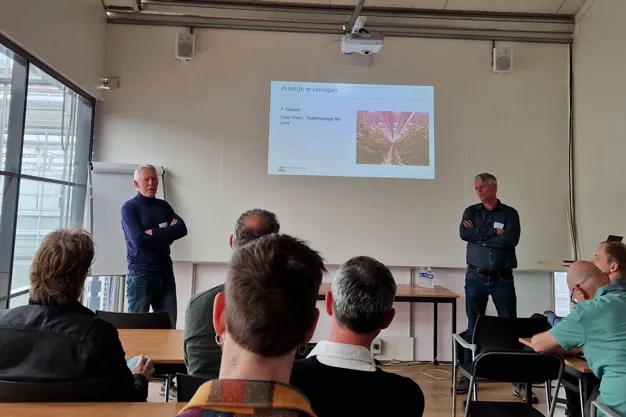
Cees Maan from Lans and Jaco den Bakker of WUR.
Introducing heat: how and where?
Challenges are always present. Lans is still considering where exactly they want to introduce heat in the crop. It's crucial not to let the ripening time of the fruits take too long, Cees emphasized. His experience is that especially in early lit cultivation, the growth duration of the fruits is long in the heart of winter. Cees explains this by rapid plant growth in the autumn, after which the daily temperature drops in November and December, possibly extending the growth duration. "With a later planting in October, this is less of a problem."
Cucumber cultivation also saw an increase in lighting last winter. Rens Smith, cultivation advisor at Delphy, shared his experiences. Like Cees, he noted that it seems that with higher intensity lighting, the evaporation troubles will quickly diminish. Then the discussion switched to the question: How quickly do you switch your lighting on and off? Suddenly turning on all the lights is not advisable. Lans ramps up from 0 to 300 micromoles in 1 hour, in two steps. "Just like how we ramped up to 200 micromoles in two steps with HPS." Cees' advice: make sure the crop is already warmed up before the lighting goes on. At the end of the day, Rens sees that many growers switch off 'along with the daylight'.
Jaco den Bakker, former grower and now working at WUR, kicked off the workshop and also concluded it. His conclusion: with higher light intensities, the problem with evaporation decreases and the situation is 'acceptable'. However, it remains worth researching how and where to introduce the extra heat in the cultivation. Cees: "You need a certain energy base for quality." An additional challenge: tomato growers are cultivating with many new, ToBRFV-resistant varieties. As a grower from the audience concluded: 'As both the LED lighting and the variety is new, you have to learn to grow all over again.'
Controlling with spectrum
As with previous events on lighting, there was no one single answer to the question 'how to grow with LED'. The matter is still too complex. Consider, for example, the spectrum, which Kees Weerheim of WUR extensively covered in his workshop.
The researcher discussed various trials, including in the cultivation of greenhouse vegetables. Here, growers want to know how they can influence the plant by shifting the spectrum. Kees' preliminary conclusion: going for shoot uniformity is not easy. Those who want to achieve uniform shoots might do better to increase the light intensity, it seems.
Viewing trials: moisture problems
Besides workshops, there was a choice of three tours. In the Delphy Improvement Centre, trials in vegetables and ornamentals could be viewed. At WUR, participants saw a mix of both vegetable and ornamental trials.
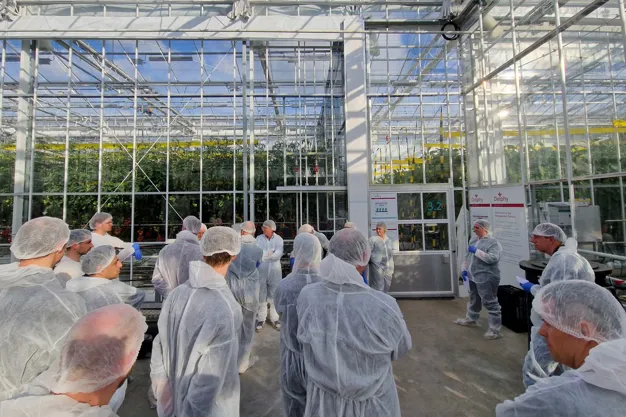
Linda Nooren explains a trial with eggplant LED cultivation.
Linda Nooren and Stijn Jochems of Delphy took a group along the vegetable trials. In an ongoing LED trial in eggplant, the preliminary conclusion is that it's mainly still searching for a suitable variety before all LED settings can be adjusted for optimal cultivation. Stijn: "Our idea is that the current spectrum is good enough."
In a tomato trial, researchers are trying to pinpoint evaporation and the problems growers experience with it in practice. As a cause of evaporation problems, unevenly colored fruits were reported among others. Two greenhouses with different humidity levels were otherwise kept identical. The preliminary conclusion: lower evaporation does not necessarily cause the problems encountered in practice.
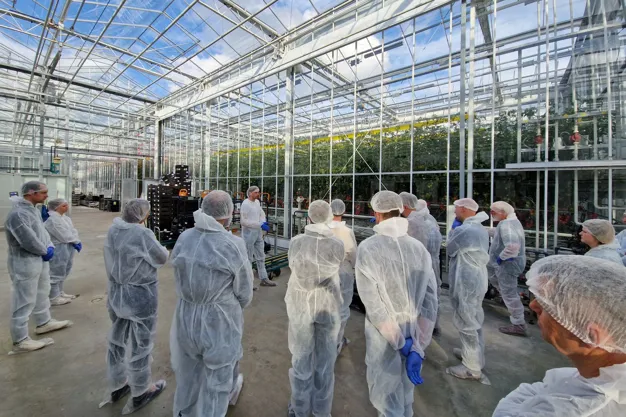
Stijn Jochems discusses a tomato trial focused on evaporation.
Technical innovations
Technical innovations are also moving on. In an eggplant trial, low-E glass is being tested again, simultaneously with a reference cultivation at the practical grower Greenbrothers. In a large trial, researchers are also looking at the combination with active dehumidification, where heat from greenhouse air is recovered and reintroduced into the greenhouse. This results in very low gas consumption. The ultimate goal: to use a maximum of 11-12 cubic meters per square meter per year.
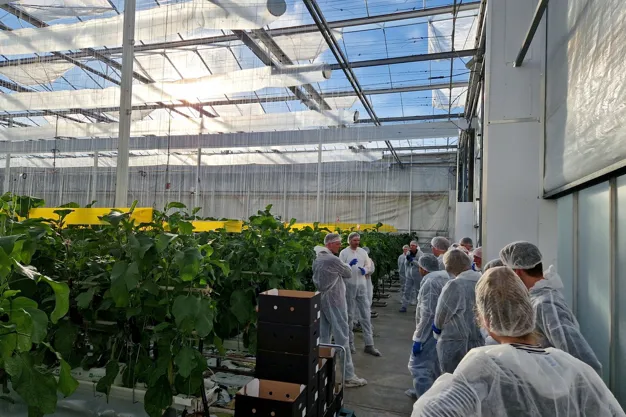
Ducts above and below the crop in a greenhouse with low-E glass.
Particularly eye-catching is the specially adapted greenhouse for a trial by Horconex and Voltiris. Kaz Vermeer Swiss startup briefed participants on harvesting solar energy with a smart solar panel system within the greenhouse. A secondary benefit now also being explored is how the system can contribute to reducing heat in the greenhouse. The system with solar panels that can rotate with the sun can also reduce intense sun radiation.
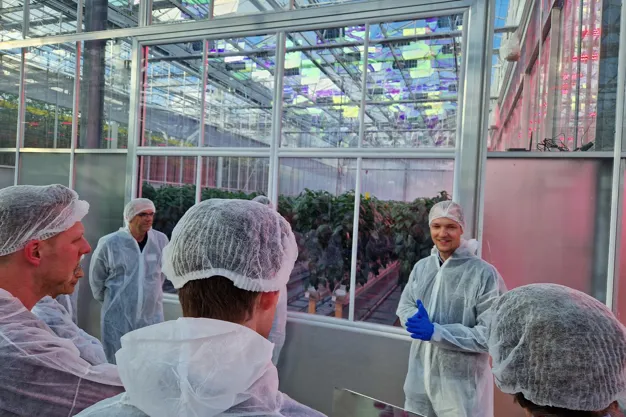
Kaz Vermeer in front of the greenhouse specially adapted for a trial with Voltiris' innovation. The complete shade screen is lowered by one meter for integration of the special solar panels in the greenhouse.
Even more control options
For those not yet filled with information, there was finally a glimpse of a trial by the Canadian lighting supplier Sollum. It is one of the (still) few parties where the spectrum is also controllable. This just goes to show that, even though LED has been actively used for already about ten years, there are new possibilities every year. Simply hanging a mix of green-blue light in the greenhouse is no longer sufficient. Something growers also realize, hence the high turnout once again at the LightEvent.
Next stop: the EnergyEvent in the summer. Because without energy, there's no lighting.
